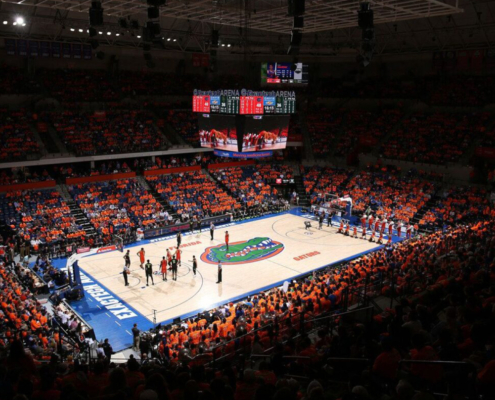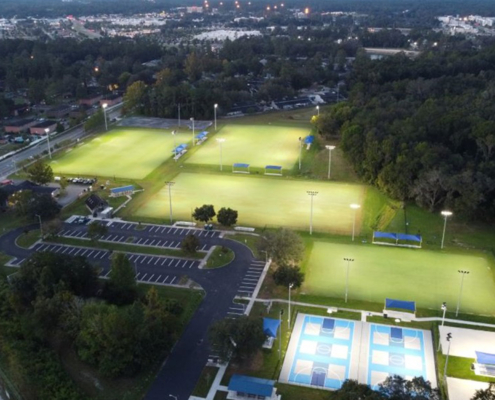 https://ngusportslighting.com/wp-content/uploads/2022/05/Homepage-Banner-2-Florida-Gators.jpg
1250
2000
AbstraktMarketing
/wp-content/uploads/2022/08/NGU-Full-Logo.png
AbstraktMarketing2024-06-18 14:33:252025-06-25 15:27:14University LED Arena Light Fixtures Guide: Types, Cost & Funding
https://ngusportslighting.com/wp-content/uploads/2022/05/Homepage-Banner-2-Florida-Gators.jpg
1250
2000
AbstraktMarketing
/wp-content/uploads/2022/08/NGU-Full-Logo.png
AbstraktMarketing2024-06-18 14:33:252025-06-25 15:27:14University LED Arena Light Fixtures Guide: Types, Cost & FundingThe Complete Guide to Wireless Lighting Control
Wireless lighting control systems have revolutionized the way we illuminate our sports facilities and venues. In this comprehensive guide, we’ll explore their various aspects, from essential elements to greater benefits, so you can make informed decisions for your next LED system.
What Are Wireless Lighting Control Systems?
A wireless lighting control system uses wireless communication to send control signals to a lighting system. Unlike wired systems, they are easier to install and can be placed in any location without worrying about extensive cabling infrastructure. They also offer greater versatility, allowing for personalized lighting settings and easy integration with other wireless devices. Furthermore, one can perform repair and maintenance with less disruption to daily operations.
How Does a Wireless Lighting Control System Work?
Wireless lighting control systems function through a combination of hardware and software. The hardware consists of light fixtures, sensors, and control points, all communicating with each other and a central control unit. When a user sends a control signal through integrated software, it travels through wireless transceivers to automated switches and dimmers that adjust brightness, color temperature, and other variables according to the command.
More advanced systems can feature secondary daylight zones, which enables the lights to spend energy more efficiently. They use sensors to monitor the amount of natural light in an environment and adjust the artificial lighting accordingly.
When designing a wireless control system, several factors must be considered. These include the efficiency of the communication between control points, the interference vulnerability of the control signal, the system’s ability to securely share and distribute the control signals, and its compatibility with level lighting controls.
Wireless lighting control systems are great for any sport venue. As are LED solutions. If you haven’t made the switch today, discover all the benefits you can receive from providers like NGU Sports Lighting.
The Different Wireless Lighting Control Systems
As innovative, energy-efficient, remote-controllable lighting dynamics, wireless lighting control systems can be grouped into several categories.
Power Line Communication (PLC)
PLC utilizes established infrastructure by sending some control signals over existing power lines, reducing the installation and maintenance costs.
Radio Frequency (RF)
RF wireless systems transmit control signals as radio waves through a remote control or smart device. These systems are perfect for users lighting large spaces as the control signal can cover a vast area.
Infrared (IR)
IR is a line-of-sight wireless control system. It requires the remote to point directly at the fixture to work, making it a compelling option for personal control.
Visible Light Communication (VLC)
VLC illuminates LED lights at different intensities to create a control point. Not only does it provide a high level of lighting controls for secondary daylight zones, it also keeps the system in energy code compliance.
Benefits of Wireless Lighting for Your Facility
Adopting wireless lighting control systems offers multiple benefits.
Improved Accessibility and Convenience
A key benefit of using a wireless control system is the level of control it offers. Adjusting the lighting in hard-to-reach places or instantly changing the mood of a room happens with just a tap on your device.
Energy Efficiency
By setting up secondary daylight zones, wireless lighting control systems take advantage of natural light, reducing the need for artificial light during the day. This adheres the system to energy codes and saves money in the process.
Lower Installation and Maintenance Costs
Since wireless lighting systems don’t require comprehensive rewiring, they pose fewer setup challenges than wired systems. The installation and maintenance costs are also lower, which amounts to considerable savings in the long run.
Automatic Commissioning
In advanced wireless lighting control systems, automatic commissioning automates the initial setup process and assures the system’s performance. It verifies that all devices in the network are operational and that all control strategies, such as scheduling and daylight-responsive controls in the secondary daylight zones, are correctly implemented.
Flexibility
Wireless lighting controls can accommodate layout changes, extend to newly constructed areas, or scale back if necessary. This flexibility allows you to adapt your lighting control system to exactly fit your needs and preferences.
Scalability
Able to easily expand to cover larger areas and additional buildings or retract when no longer needed, wireless lighting control systems are extremely scalable. This makes them a cost-effective choice for growing businesses and adaptable environments.
Partner With NGU Sports Lighting for the Best Wireless Lighting Controls In Your Venue
Partnering with NGU Sports Lighting for the best wireless lighting controls that provide unparalleled benefits and cutting-edge technology. NGU Sports Lighting has established itself as a leading provider in the industry, offering state-of-the-art solutions that revolutionize how sports venues are illuminated. With our advanced wireless lighting controls, you gain the power to effortlessly manage and customize your lighting systems, enhancing the overall experience for players and spectators. Contact our team to get started today.




